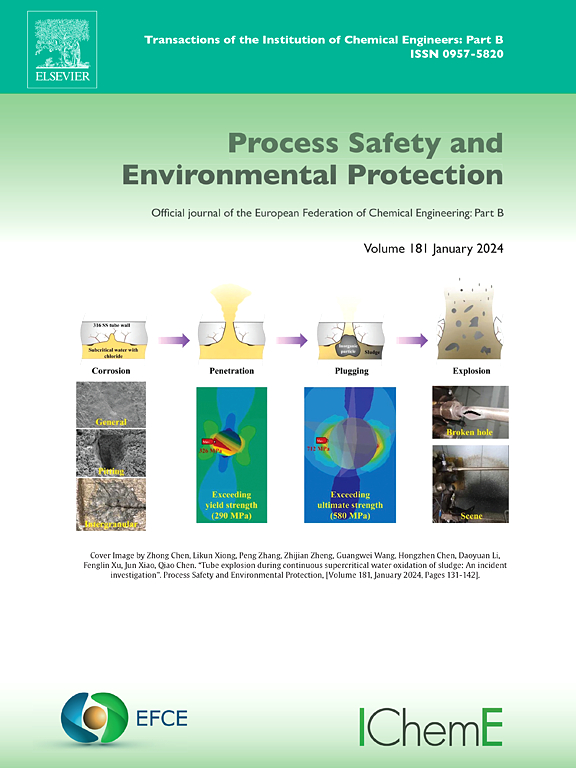Fe-Mg/PDA@Al2O3催化臭氧氧化法去除水中环丙沙星的性能及机理
IF 6.9
2区 环境科学与生态学
Q1 ENGINEERING, CHEMICAL
引用次数: 0
摘要
目前迫切需要开发去除废水中环丙沙星(CIP)的技术,因为它在人类和动物群体中广泛使用并随后传播到地表水中。铝(Al2O3)是一种优良的载体,而聚多巴胺(PDA)是一种高氮含量和强附着力的表面改性剂,可能是去除废水中CIP的潜在工具。然而,利用PDA改善载体与活性组分之间的相互作用,从而提高臭氧利用效率以及CIP去除方案的催化活性和稳定性的研究很少。为了解决这一研究空白,研究成功制备了Fe-Mg/PDA@Al2O3复合材料,用于催化臭氧去除水中的CIP。提出了臭氧催化处理环丙沙星废水的影响因素、降解机理及可能的抗生素降解途径。除催化剂吸附和直接臭氧氧化外,CIP的去除主要通过以羟基自由基(•OH)为主的间接氧化进行,并且CIP的氧化降解符合准一级反应动力学模型。在理想操作条件下,15 min后Fe-Mg/PDA@Al2O3/O3体系的CIP降解效率达到91.35 %。Fe-Mg/PDA@Al2O3/O3体系的矿化效率显著高于单臭氧体系。Fe-Mg/PDA@Al2O3经过4次重复使用后,CIP降解效率保持稳定,金属离子浸出浓度在限定范围内,说明Fe-Mg/PDA@Al2O3具有较高的催化性能和稳定性。本文章由计算机程序翻译,如有差异,请以英文原文为准。
Performance and mechanism of ciprofloxacin removal in water via catalytic ozonation using Fe-Mg/PDA@Al2O3
There is currently an urgent need to develop technologies for ciprofloxacin (CIP) removal in wastewater owing to its widespread usage in human and animal populations and subsequent transmission into surface water. Aluminum (Al2O3) is an excellent carrier, and polydopamine (PDA) is a surface modifier with a high nitrogen content and strong adhesion, and may represent a potential tool for CIP removal in wastewater. However, minimal research has been conducted on using PDA to improve the interactions between carrier and active components and thus improve the ozone utilization efficiency as well as catalytic activity and stability in CIP removal schemes. To address this research gap, study successfully prepared Fe-Mg/PDA@Al2O3 composite materials for the catalytic ozone removal of CIP from water. The influencing factors and degradation mechanisms of the catalytic ozone treatment of ciprofloxacin wastewater and possible antibiotic degradation pathways were proposed. The removal of CIP was mainly carried out through indirect oxidation dominated by hydroxyl radicals (•OH), in addition to catalyst adsorption and direct ozone oxidation, and the oxidative degradation of CIP conformed to a pseudo-first-order reaction kinetic model. Under ideal operating conditions, the CIP degradation efficiency of Fe-Mg/PDA@Al2O3/O3 system reached 91.35 % after 15 min. The mineralization efficiency of Fe-Mg/PDA@Al2O3/O3 system was significantly higher than that of the single-ozone system. After four repeated uses of Fe-Mg/PDA@Al2O3, the CIP degradation efficiency remained stable, and the metal ion leaching concentration was within the limit, indicating that Fe-Mg/PDA@Al2O3 demonstrated a high catalytic performance and stability.
求助全文
通过发布文献求助,成功后即可免费获取论文全文。
去求助
来源期刊

Process Safety and Environmental Protection
环境科学-工程:化工
CiteScore
11.40
自引率
15.40%
发文量
929
审稿时长
8.0 months
期刊介绍:
The Process Safety and Environmental Protection (PSEP) journal is a leading international publication that focuses on the publication of high-quality, original research papers in the field of engineering, specifically those related to the safety of industrial processes and environmental protection. The journal encourages submissions that present new developments in safety and environmental aspects, particularly those that show how research findings can be applied in process engineering design and practice.
PSEP is particularly interested in research that brings fresh perspectives to established engineering principles, identifies unsolved problems, or suggests directions for future research. The journal also values contributions that push the boundaries of traditional engineering and welcomes multidisciplinary papers.
PSEP's articles are abstracted and indexed by a range of databases and services, which helps to ensure that the journal's research is accessible and recognized in the academic and professional communities. These databases include ANTE, Chemical Abstracts, Chemical Hazards in Industry, Current Contents, Elsevier Engineering Information database, Pascal Francis, Web of Science, Scopus, Engineering Information Database EnCompass LIT (Elsevier), and INSPEC. This wide coverage facilitates the dissemination of the journal's content to a global audience interested in process safety and environmental engineering.
 求助内容:
求助内容: 应助结果提醒方式:
应助结果提醒方式:


